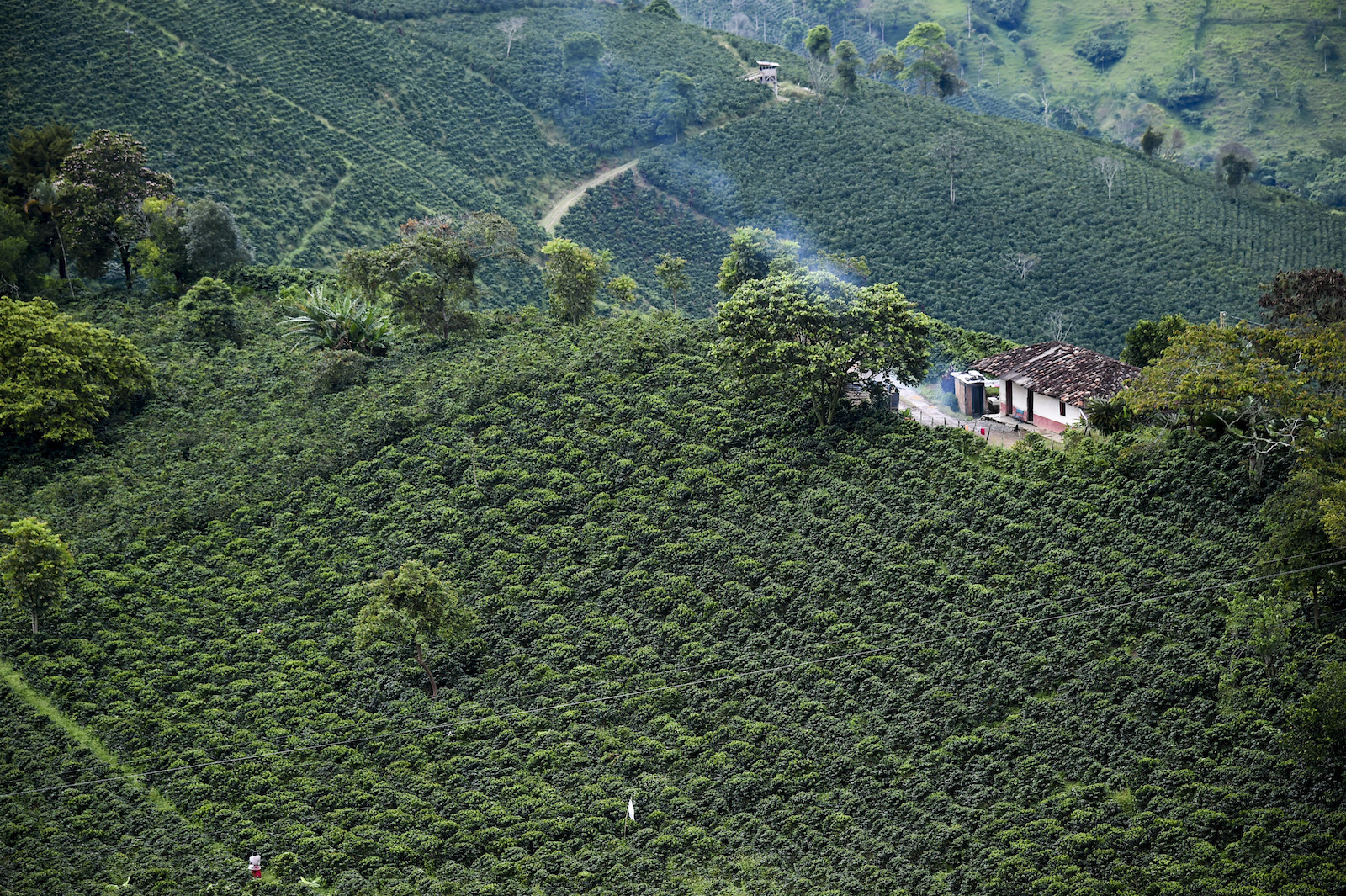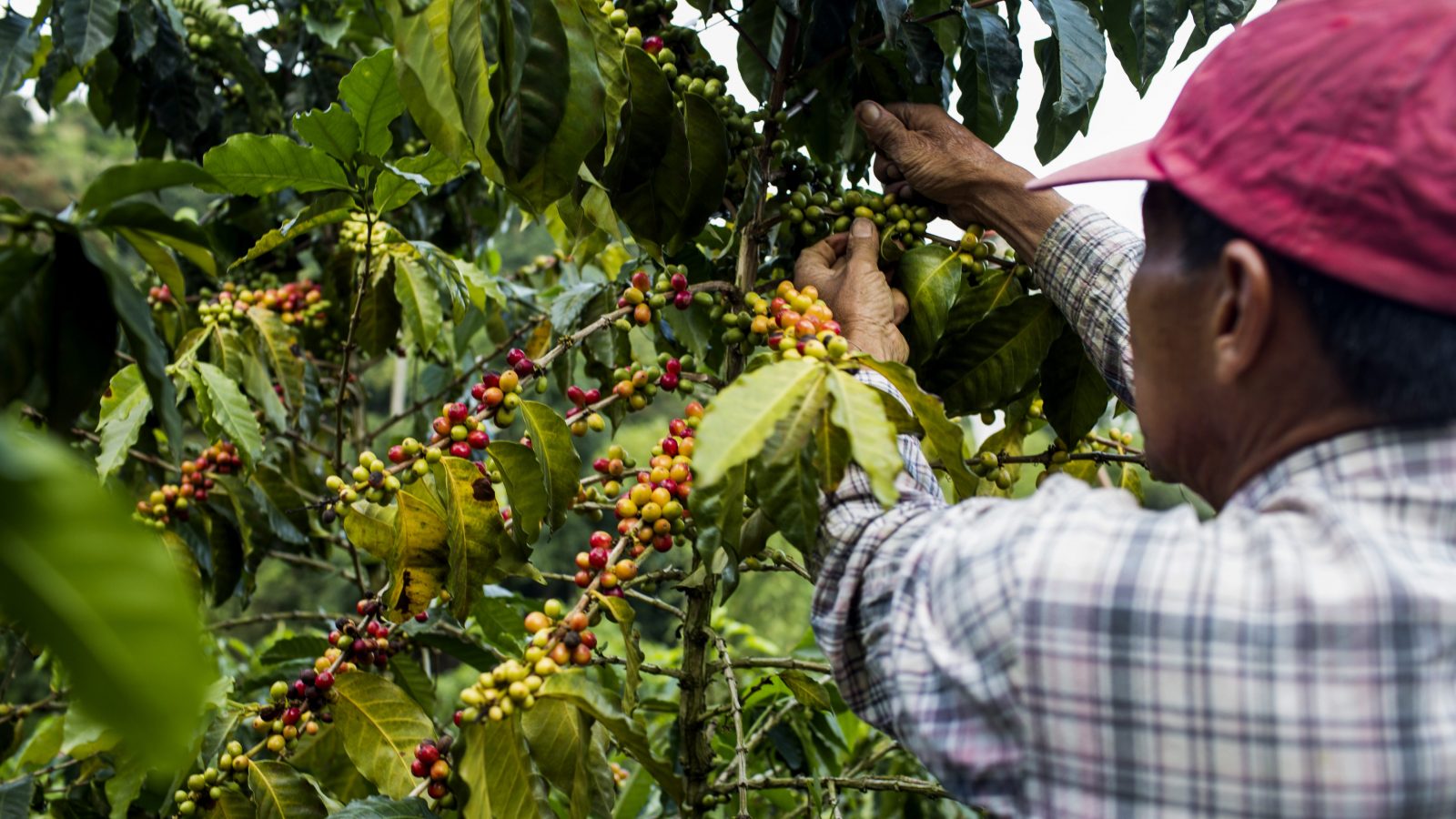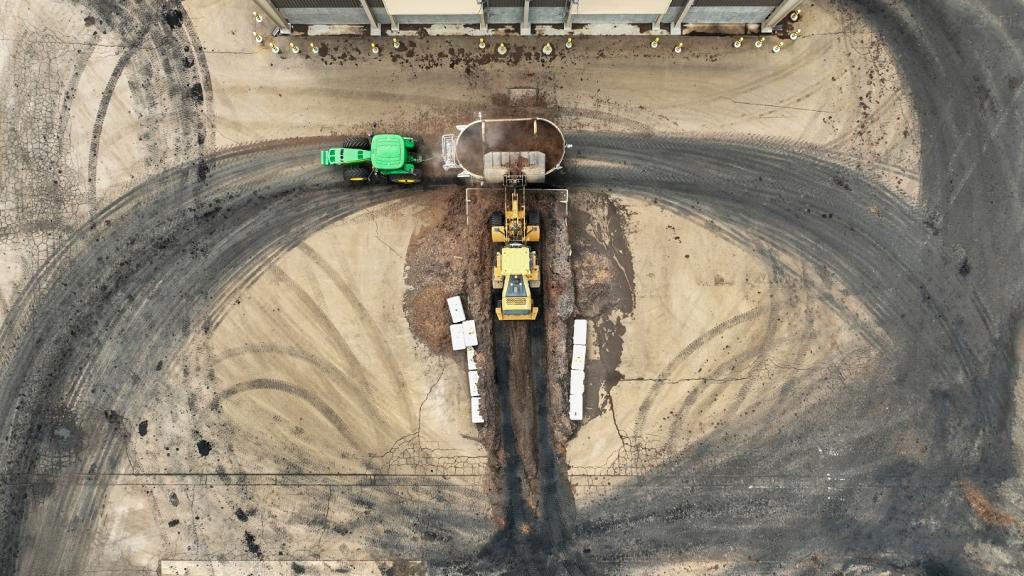This story was originally published by Yale Environment 360 and is reproduced here as part of the Climate Desk collaboration.
At first glance, Finca El Ocaso, located in the hills outside Salento, Colombia, could be mistaken for a natural forest: Rows of squat Arabica coffee trees are interspersed with plantain, banana, and lime and shaded by towering nogal cafatero trees, whose high canopy hosts flocks of chattering parrots and other birds. The 44-acre coffee plantation has been certified by international organizations for being sustainable, climate-friendly, and fair to its workers.
But Finca El Ocaso is struggling under the weight of intensifying economic pressures.
“Lots of smaller farms near us have gone out of business,” said farmer Gustavo Patiño. “It is no longer sustainable to have a medium-size farm that pays high taxes and expensive production costs, when in the end they may get paid less for their coffee than their expenses.”
Several years ago, in an effort to keep the plantation afloat, Patiño’s eldest daughter, Carolina, opened the farm to foreign and Colombian tourists. The plantation now attracts more than 1,000 visitors a year. “Our farm can only survive because we offer tours and sell our coffee to the tourists,” Patiño said.
In the last 18 months, Colombia has lost nearly 100,000 acres of coffee plantations, more than 4 percent of the land under coffee cultivation, according to a statement issued last week by Colombia’s National Federation of Coffee Growers (Fedecafé). Since the 1990s, the total land under coffee cultivation has shrunk by 20 percent, Fedecafé said. The federation largely attributed the most recent exodus to the ruinously low price for coffee on the New York exchange. The migration of younger laborers to higher-paying jobs in the cities and abroad is also a factor, notes Diana Carolina Meza Sepulveda, a professor of agro-industrial development at the Technical University of Pereira.
Yet beyond these immediate economic concerns looms a threat that is already affecting some of Colombia’s coffee growers: a changing climate. The Colombian mountain region, where coffee is grown, is warming by 0.3 degrees Celsius (0.5 degrees Fahrenheit) per decade, according to a study published in April by coffee agronomist Peter Baker and a team of scientists. The number of hours of sunlight also has declined by 19 percent since the middle of the last century due to increasing cloud cover, and there is no longer enough sun to sustain high levels of coffee production in some areas, the researchers reported. Precipitation extremes are more common, as is the spread of insect and fungal diseases — plagues driven in part by generally warmer, wetter weather.
Indeed, Colombia’s increasingly volatile growing conditions pose the biggest long-term threat to the nation’s small coffee growers, scientists say. Of Colombia’s half-a-million coffee farms, 95 percent are smaller than 12 acres. “In the Central Coffee Zone, their output is declining quite fast,” says Baker, who works with the Initiative for Coffee and Climate. “Bad weather and coffee diseases are clearly a factor.”
For now, warming weather has worked in favor of the Patiños. But the long-term climatic trends do not bode well.
“When we started the plantation, the neighbors said that we were crazy, it is too cold for coffee — now the altitude [of 5,800 feet] is just right for growing it,” said Patiño who bought the land in 1987. “I have noticed big weather changes in the last 30 years. On the one hand, we have more extremely sunny days, and at other times there is too much rain.”
The Zona Cafetera, as Colombians call the fertile triangle in the central cordillera of the Andes where Finca El Ocaso is located, is a patchwork of small farms, remnant cloud forest, and high mountain ridges. UNESCO designated the picturesque region a World Heritage site in 2011, calling it “an exceptional example of a sustainable and productive cultural landscape” and “a strong symbol for coffee growing areas worldwide.”
But the postcard good looks conceal a more complex reality.
Jessica Eise, a Purdue University Ph.D. student working to create a climate change adaptation information network in Colombia, recently completed a study of the impact of climate change on Colombia’s coffee farmers. More than 90 percent of the farmers she interviewed reported changes in average temperature, 74 percent said droughts had gotten longer and more severe, and 61 percent reported an increase in mountainside erosion and landslides caused by heavy rains. Most coffee farmers noticed changes in their trees’ flowering and fruiting cycles, Eise said.
“In earlier times, the climate was perfect for coffee,” said one small farmer who spoke with Eise and asked not to be identified. “In the period of flowering, there was summer. During harvest, there was winter. But from 2008 onward, this changed and we now don’t know when it will be summer, when the coffee will blossom. Our yearly production now varies by up to 40 percent.”
The Colombian representative of the Rainforest Alliance, Mauricio Galindo, said that “precipitation levels that would usually occur over a period of three months were concentrated over a two week period this year,” disrupting coffee bean development, which requires extended periods of gentle rain.
Coffee trees are acutely sensitive to small changes in the weather. Too much sun or too little, too much rain or too little, can play havoc with the flowering and ripening cycle of the coffee cherry, which harbors the developing bean. Temperature is equally critical. The trees do best with warm spring-like days and cool nights, an important reason why the crop only flourishes in a narrow band of elevations in the tropics where conditions are just right. But as global warming progresses, the sweet spot where it can be grown is moving steadily up mountain slopes.
Some growers at lower elevations have ripped out their under-performing trees, Galindo said, the land reverting to cattle pasture or used to grow high-value crops like avocado and coca leaf, the source of cocaine, which remains the country’s leading agricultural money earner. (Coffee is second.) Meanwhile, in the south of the country, virgin high mountain forests where temperatures are cool are being felled to make way for new coffee plantations, Galindo reports.
The small size of Colombia’s mom and pop coffee plantations has allowed the quality and consistency of the coffee to remain high, a major selling point. But most farms remain nonmechanized and are labor intensive, putting Colombia at a disadvantage against other countries with more efficient production systems.

An aerial view of coffee plantations in Santuario, Colombia in May. Small farms such as these have been hit hardest by climate change and low coffee prices. Raul Arboleda / AFP / Getty Images
Ironically, the improvement in the Colombian economy, the so-called peace dividend that followed the signing of the treaty with FARC guerrillas in 2016, has hurt its coffee business. The Colombian peso is currently strong, making the country’s coffee exports less competitive on the global market compared to players like Vietnam and Brazil. Moreover, the new prosperity has led to a building boom in Colombia’s cities, leading to a labor shortage.
“There aren’t enough workers,” a farmer who spoke to the Purdue team reported. “There aren’t any youth left on my farm. I have two men working for me, one is 83 years old and the other is 75 years old, and then there is me.”
For large plantations, these kinds of economic stressors are still manageable. Many are currently diversifying their crops to better weather the years when the coffee harvest is poor. But for a small holder living on the edge of financial solvency, a single bad year poses an existential threat. Some growers have implemented stopgap measures like installing rain-fed water tanks to irrigate their land during drought.
But even these modest steps are beyond the means of many small growers. “You can’t adapt to climate change when you are in poverty,” Eise explained. “And climate change exacerbates the stress of poverty. It’s a catch-22.”
“It just seems like everything is continually getting more extreme for them,” said Baker. “What all farmers want is reasonably stable conditions and they are not getting them and, frankly, it should be made clear to them that they will never return to the stable conditions of the past.”
The slim profit margin of coffee farmers — even in good years — is further eroded by an obligatory fee that growers pay to Fedecafé, the nonprofit organization that partners with the Colombian government. Fedecafé, best known for its “Juan Valdez” marketing campaign, buys farmers’ harvests and sells them to the world. Eduardo Lora, an associate at Harvard’s Center for International Development, says that this fee, the equivalent to a tax rate of 15.3 percent on farmer income, has placed yet another burden on the small landholders who can least afford it.
But Fedecafé also funds a research arm, Cenicafé, whose 60 scientists are expected to play a key role in helping Colombia’s coffee growers survive in the coming decades. Dubbed “the NASA of world coffee” because of its high-tech approach to developing new tree varieties that are resistant to pests and adapted to the vagaries of a shifting climate, the laboratory is perched on a mountainside above the central Colombian town of Chinchina. On the terrace outside the office of director Alvaro Gaitan, a plant pathologist, are a variety of potted coffee trees sporting a mix of green and red cherries.
“These two plants are the parents of Arabica coffee,” Gaitan said. “We’ve sequenced the genomes of these as well as other varieties and the information is now publicly available. They are going to give us the genes to design new varieties in the future.”
Collections like these are critical, as the genetic information they contain is the first line of defense against coffee pathogens. Coffee leaf rust, or la roya in Spanish, turns leaves yellow and prevents trees from fruiting. An epidemic of the fungus in 2012 devastated coffee farms throughout Latin America, causing more than $3 billion in damage and lost income, and effectively derailing the coffee industry in countries such as El Salvador.
The impact was much less severe in Colombia, where Cenicafé had already used its wild coffee gene bank to develop leaf rust-resistant varieties that were suited to growing conditions in various parts of the country. A team of 1,200 extension agents aggressively promoted the resistant variety called “Castillo,” and by 2017 roughly three-fourths of the coffee trees in Colombia were leaf rust-resistant.
“You can’t find another example of a change made so fast in a perennial crop anywhere in the world,” Gaitan said. “We know that the rust and other pests are still trying to beat us. We are designing plants for drier environments, we are designing plants for wetter environments. Colombia has many different climate zones and we simply don’t know what is going to happen in the future.”
Instead of providing seeds of just one genotype, each bag that Cenicafé sells to coffee farmers at cost contains seeds of 35 different lines, ensuring that some plants will manage to thrive whatever environmental conditions might arise.
While land planted in coffee in Colombia has shrunk by a fifth, coffee production has remained roughly the same since the 1990s, due to increased efficiencies in the production process, such as planting more trees per acre; biological controls for insect pests; and other agronomic innovations pioneered by Cenicafé. Gaitan says he is confident that further technological developments can help Colombia — and the world — keep pace with future threats.
Others, however, are not so sure. “Climate change will reduce the global area suitable for coffee by about 50 percent across emission scenarios,” according to a report published in the journal Climatic Change in 2015.
The coffee trade is worth more than $100 billion a year globally. Yet the amount of coffee research worldwide “is minuscule in comparison to other crops,” says Hanna Neuschwander, communications director of World Coffee Research, a trade group. The biggest need is for better science to be conducted at the local level to adapt coffee to climate change on a country-by-country basis, as Colombia is doing.
If that happens, she predicts, coffee will successfully meet the challenges of climate change and continue to be grown. Unfortunately, Neuschwander said, many of the smaller farmers whose families have cultivated the beloved bean for generations will face the greatest pressure.
“Any negative shocks — a disease outbreak, a drought, low market prices — are going to disproportionately affect the people who have the least ability to absorb them,” Neuschwander said. “Over the next 50 years you are going to see a trend toward consolidation where only the most efficient producers can stay in the game.”



